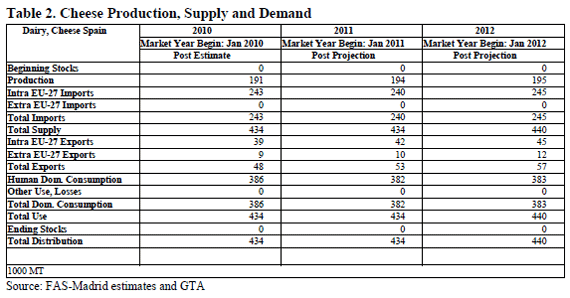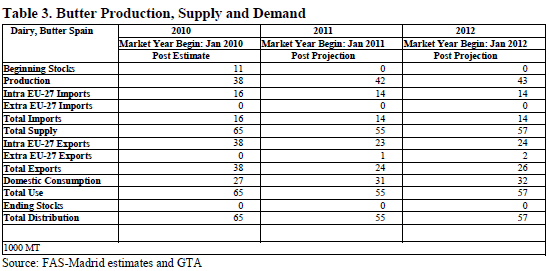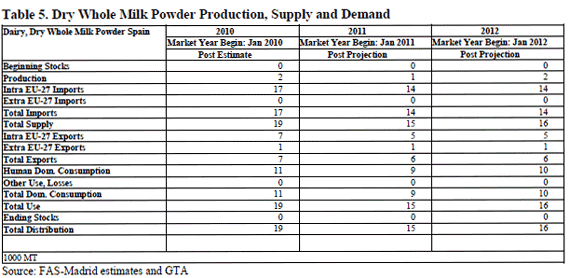



Spain Dairy Annual Voluntary Report 2011
Spain is one of the few EU countries with a structural deficit of milk production that is enshrined in its quota allocation, according to the USDA Foreign Agricultural Service.General Information:
Milk
Cow milk deliveries will increase in 2011 accompanying a 17,000 head increase in the dairy heard in the December 2010 census from the previous year. There has been a decrease in household consumption of fluid milk as the macroeconomic environment shows no sign of improving and unemployment continues to hover above 20 per cent. Intra EU-27 imports of fresh milk are expected to keep the downward trend in 2011 and 2012, while extra EU-27 imports continue to be zero. Exports to the EU and to third countries are relatively constant.

The Spanish Fund for Agricultural Guarantee (FEGA) published its final report for the 2010/2011 campaign where it evaluates data from annual milk deliveries and direct sales from the annual declarations for the period. Data submitted shows that 8,298 producers delivered milk in excess of their available reference quantity with a total excess of 318,373,575 kg. On the other hand, 13,147 producers delivered milk below or at the level of their available reference quantity, generating 403,432,559 kg of milk that was not delivered. Spain will not have to pay any amount to the European Agricultural Guarantee Fund (EAGF).
Supply contracts:
In the current 2011/12 campaign there are 1,542 million litres of milk under homologated supply contracts in Spain, according to the latest data published in July. Although the number of contracts currently in force, including those prorogated (5,712) outnumbers last season?s 5,545, the volume of milk contracted is 861 million litres lower. This season has also seen a shortening of the average duration of contracts (5.4 months against 7.4 months in the previous campaign) implying that buyers and sellers are looking for shorter term commitments. There is also an increase in the contracts that have a monthly fixed price: 4,074 so far this season against a total 3,856 in the last campaign or 1,243 in 2009/10. On the other hand, the volume contracted at a price fixed for the whole duration of the contract seems to be lower: 1.5 million litres so far his campaign against 2.4 million litres in the previous campaign.
Cheese
Cheese production is expected to increase at about 2 per cent a year reaching 195,000 tons in 2012. Human domestic consumption of medium and hard cheese is showing a slight decrease in 2011. Both imports and exports are expected to grow in 2011 and 2012. Imports of cheese are forecast to reach 245,000 tons in 2011, almost all from intra EU-27 countries. Exports may reach 57,000 tons, 80 per cent of which are destined to other EU-27 Member States.

Butter
Butter production is increasing in Spain. Total production in 2011 is expected to reach 42,000 tons, a 10 per cent increase from the previous year. Domestic consumption stands at around 30,000 tons per annum. All butter imports originate in EU-27 countries, mainly France, Portugal, and Germany and these are expected to remain stable in 2011. Demand from France, Belgium and the Netherlands has been lower this year and total exports are expected to fall from the 2010 hike to be around 24,000 tons in 2011. Exports to extra EU-27 countries are however expected to rise to over 1,000 tons with countries like Algeria and territories like Ceuta and Andorra increasing orders from Spain. During the 2010 period there were no intervention purchases for butter. Since 1 March 2011, with the opening of the latest intervention period, to date there have been no offers and as such there are no intervention stocks for 2011.

Non Fat Dry Milk
Production of Non Fat Dry Milk is small in Spain but is increasing and is expected to reach 11,000 tons by the end of 2011. Human domestic consumption is stable at around 49,000 tons. Other uses include 3,000 tons incorporated to animal feed. Imports, all from intra EU-27 countries, are expected to increase slightly and reach 48,000 tons in 2011. Exports have risen steadily in the first five months of 2011 and are expected to reach 7,000 tons by the end of the year. During the 2010 period there were no intervention purchases of non fat dry milk. Since March 1, 2011, with the opening of the latest intervention period, there have been so far no offers and as such there are no intervention stocks for 2011.

Dry Whole Milk Powder
Production is very small in the country swinging at around 2,000 tons per annum. Annual consumption is slightly diminishing and it stands currently at below 10,000 tons. Trade is slowing down with both imports and exports expected to be around 17 per cent lower in 2011. All imports come from EU-27 countries and are projected to reach 14,000 tons in 2011. France and Portugal are the destiny to over 80 per cent of the WMP exported by Spain. Extra EU-27 exports will account for only 10 per cent of the total 6,100 tons expected to be exported by Spain in 2011.

Policy
In the year 2009 MARM released the document “Strategy for the Spanish Dairy Sector – "Horizon 2015" and it has been proceeding to its implementation ever since. The objectives of this strategic plan are to increase the sector?s competitiveness and market orientation while contributing to the development of rural areas where this sector has a key presence, thereby allowing the settlement of population in rural areas. The plan is based on measures and proposals that encompass the whole of the challenges faced by the dairy sector in Spain.
Further Reading
| - | You can view the full report by clicking here. |
November 2011


